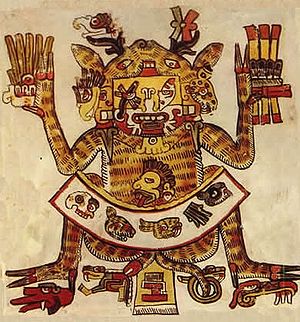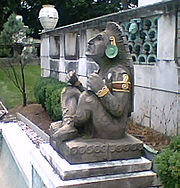
Xochipilli
Encyclopedia

Aztec mythology
The aztec civilization recognized a polytheistic mythology, which contained the many deities and supernatural creatures from their religious beliefs. "orlando"- History :...
. His name contains the Nahuatl
Nahuatl
Nahuatl is thought to mean "a good, clear sound" This language name has several spellings, among them náhuatl , Naoatl, Nauatl, Nahuatl, Nawatl. In a back formation from the name of the language, the ethnic group of Nahuatl speakers are called Nahua...
words xochitl ("flower") and pilli (either "prince" or "child"), and hence means "flower prince". As the patron of writing and painting, he was called Chicomexochitl "Seven-flower", but he could also be referred to as Macuilxochitl "Five-flower". His wife was the human girl Mayahuel
Mayahuel
Mayahuel is the female divinity associated with the maguey plant among cultures of central Mexico in the Postclassic era of pre-Columbian Mesoamerican chronology, and in particular of the Aztec cultures...
, and his twin sister was Xochiquetzal
Xochiquetzal
In Aztec mythology, Xochiquetzal was a goddess associated with concepts of fertility, beauty, and female sexual power, serving as a protector of young mothers and a patroness of pregnancy, childbirth, and the crafts practised by women such as weaving and embroidery...
. As one of the gods responsible for fertility and agricultural produce, he was also associated with Tlaloc
Tlaloc
Tlaloc was an important deity in Aztec religion, a god of rain, fertility, and water. He was a beneficent god who gave life and sustenance, but he was also feared for his ability to send hail, thunder and lightning, and for being the lord of the powerful element of water. In Aztec iconography he...
(god of rain), and Cinteotl (god of maize). Xochipilli corresponds to the Tonsured Maize God among the Classic Mayas.
Xochipilli was also the patron of both homosexuals and male prostitutes, a role possibly resulting from his being absorbed from the Toltec
Toltec
The Toltec culture is an archaeological Mesoamerican culture that dominated a state centered in Tula, Hidalgo in the early post-classic period of Mesoamerican chronology...
civilisation
Xochipilli Statue

Popocatépetl
Popocatépetl also known as "Popochowa" by the local population is an active volcano and, at , the second highest peak in Mexico after the Pico de Orizaba...
near Tlalmanalco
Tlalmanalco
Tlalmanalco is a town and municipality located in the far south-eastern part of the State of Mexico. The name is from the Nahuatl language, meaning “flat area.” The municipality’s seal shows flat land, with a pyramid on it, representing its pre-Hispanic history, surrounded by small mountains, which...
. The statue is of a single figure seated upon a temple-like base. Both the statue and the base upon which it sits are covered in carvings of sacred and psychoactive
Psychoactive drug
A psychoactive drug, psychopharmaceutical, or psychotropic is a chemical substance that crosses the blood–brain barrier and acts primarily upon the central nervous system where it affects brain function, resulting in changes in perception, mood, consciousness, cognition, and behavior...
organisms including mushrooms (Psilocybe aztecorum
Psilocybe aztecorum
Psilocybe aztecorum is a species of mushroom in the Strophariaceae family....
), tobacco
Tobacco
Tobacco is an agricultural product processed from the leaves of plants in the genus Nicotiana. It can be consumed, used as a pesticide and, in the form of nicotine tartrate, used in some medicines...
(Nicotiana tabacum
Nicotiana tabacum
Nicotiana tabacum, or cultivated tobacco, is a perennial herbaceous plant. It is found only in cultivation, where it is the most commonly grown of all plants in the Nicotiana genus, and its leaves are commercially grown in many countries to be processed into tobacco. It grows to heights between 1...
), Ololiúqui (Turbina corymbosa), sinicuichi (Heimia salicifolia
Heimia salicifolia
Heimia Salicifolia is a species of flowering plant in the Loosestrife family, Lythraceae. It is native to the Americas, ranging from the southwestern United States through Mexico and Central America to Argentina...
), possibly cacahuaxochitl (Quararibea funebris
Quararibea funebris
Quararibea funebris is a tree native to Mexico...
), and one unidentified flower. The figure himself kneels on the base, head tilted up, eyes open, jaw tensed, with his mouth half open and his arms opened to the heavens. The statue is currently housed in the Museo Nacional de Antropología
Museo Nacional de Antropología
The Museo Nacional de Antropología is a national museum of Mexico. Located in the area between Paseo de la Reforma and Calle Mahatma Gandhi within Chapultepec Park in Mexico City, the museum contains significant archaeological and anthropological artifacts from the pre-Columbian heritage of...
in Mexico City
Mexico City
Mexico City is the Federal District , capital of Mexico and seat of the federal powers of the Mexican Union. It is a federal entity within Mexico which is not part of any one of the 31 Mexican states but belongs to the federation as a whole...
.
Entheogen Connection
It has been suggested by Wasson, SchultesRichard Evans Schultes
Richard Evans Schultes may be considered the father of modern ethnobotany, for his studies of indigenous peoples' uses of plants, including especially entheogenic or hallucinogenic plants , for his lifelong collaborations with chemists, and...
, and Hofmann
Albert Hofmann
Albert Hofmann was a Swiss scientist known best for being the first person to synthesize, ingest and learn of the psychedelic effects of lysergic acid diethylamide . He authored more than 100 scientific articles and a number of books, including LSD: My Problem Child...
that
the statue of Xochipilli represents a figure in the throes of entheogen
Entheogen
An entheogen , in the strict sense, is a psychoactive substance used in a religious, shamanic, or spiritual context. Historically, entheogens were mostly derived from plant sources and have been used in a variety of traditional religious contexts...
ic ecstasy. The position and expression of the body, in combination with the very clear representations of hallucinogenic
Psychedelics, dissociatives and deliriants
This general group of pharmacological agents can be divided into three broad categories: psychedelics, dissociatives, and deliriants. These classes of psychoactive drugs have in common that they can cause subjective changes in perception, thought, emotion and consciousness...
plants which are known to have been used in sacred contexts by the Aztec support this interpretation.
Wasson says "He is absorbed in temicxoch, 'the flowery dream', as the Nahua say in describing the awesome experience that follows the ingestion of Sinicuichi (Heimia salicifolia
Heimia salicifolia
Heimia Salicifolia is a species of flowering plant in the Loosestrife family, Lythraceae. It is native to the Americas, ranging from the southwestern United States through Mexico and Central America to Argentina...
). I can think of nothing like it in the long and rich history of European art: Xochipilli absorbed in temicxoch" of the statue of Xochipilli.
External links
- J. Paul Getty Museum's in-depth interactive exploring the Museo Nacional de Antropología's 15th-century basalt figure of Xochipilli. Includes a detailed exploration of pyschotropic plants depicted.
- Erowid's Xochipilli Vault

